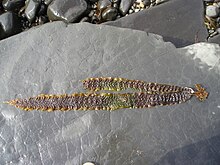Saccharina latissima is a brown alga (class Phaeophyceae), of the family Laminariaceae. It is known by the common names sugar kelp,[2] sea belt,[3] and Devil's apron,[4] and is one of the species known to Japanese cuisine as kombu.[5] It is found in the north Atlantic Ocean, Arctic Ocean and north Pacific Ocean. It is common along the coast of Northern Europe as far south as Galicia Spain. In North America, it is found on the East Coast down to Long Island, although historically extended down to New Jersey[6] and on the West Coast down to the state of Washington. On the coast of Asia, it is found south to Korea and Japan.[7]
| Saccharina latissima | |
|---|---|

| |
| Scientific classification | |
| Domain: | Eukaryota |
| Clade: | Diaphoretickes |
| Clade: | SAR |
| Clade: | Stramenopiles |
| Phylum: | Gyrista |
| Subphylum: | Ochrophytina |
| Class: | Phaeophyceae |
| Order: | Laminariales |
| Family: | Laminariaceae |
| Genus: | Saccharina |
| Species: | S. latissima
|
| Binomial name | |
| Saccharina latissima | |
| Synonyms | |
| |
Description edit
Saccharina latissima is a yellowish brown colour with a long narrow, undivided blade that can grow to 5 metres (16 ft) long and 20 centimetres (7.9 in) wide. The central band is dimpled while the margins are smoother with a wavy edge, this is to cause greater water movement around the blades to aid in gas exchange. The frond is attached to the rock by stout rhizoids about 5 mm in diameter[3] in the intertidal and sublittoral zones by a claw-like holdfast and a short, pliable, cylindrical stipe.[8]
Ecology edit
Saccharina latissima is an ecologically important system. It is a primary producer, delivering plant material to the coastal food web. The three-dimensional forests also serve as a habitat for animals, resulting in a high biodiversity. Fish, shellfish and other animals find food and hiding places within these forests.[9]
It can be infected by the pathogenic fungus (to kelp) Phycomelaina laminariae.[10]
Human use edit
Sugar kelp is used as a food in many places where it grows, one of many species often called kombu. Sugar kelp can be used as a vegetable in salads but is most frequently used in soups and stocks where it provides savory flavors and is especially highly valued in vegetarian cooking.[11] Kombu is a key component of miso soup. The savory flavor of sugar kelp comes from free amino acids like glutamate. Monosodium glutamate was first isolated from Saccharina.[12] Sugar kelp gets its name due to it containing the sugar alcohol mannitol which is extracted from it to be used as a sugar substitute, especially for chewing gum.[13]
Threats edit
In 2004, scientists reported a loss in sugar kelp of up to 80% at Skagerrak and 40% at the West coast of Norway.[2][14][15] The reasons for this loss are not fully understood, but the increase in ocean temperature, high levels of nutrients and the reduction in animal species feeding off the filamentous algae are suggested as the most likely reasons.[16]
Gallery edit
-
Saccharina latissima on a beach
-
Saccharina lattissima from Avacha Bay
References edit
- ^ Lane, C. E.; Mayes, C.; Druehl, L. D.; Saunders, G. W. (2006). "A multi-gene molecular investigation of the kelp (Laminariales, Phaeophyceae) supports substantial taxonomic re-organization". Journal of Phycology. 42 (2): 493–512. doi:10.1111/j.1529-8817.2006.00204.x. S2CID 53329947.
- ^ a b Bekkby, T.; Moy, F. (2011). "Developing spatial models of sugar kelp (Saccharina latissima) potential distribution modelling of the kelp species Laminaria hyperborea". ICES Journal of Marine Science (66): 2106–2115.
- ^ a b Dickinson, C. I (1963). British Seaweeds. The Kew Series.
- ^ "Devil's Apron". Webster's Revised Unabridged Dictionary. C. & G. Merriam Co. 1913.
- ^ "Seaweeds of the Pacific Northwest – A Guide to Identifying 25 Common Seaweeds of the Washington Coast". Retrieved 2022-08-25.
- ^ Martindale, I.C. (1889). "MARINE ALGÆ OF THE NEW JERSEY COAST AND ADJACENT WATERS OF STATEN ISLAND". Memoirs of the Torrey Botanical Club. 1 (2): 87-109,111.
- ^ Neiva, J.; Paulino, C.; Nielsen, M. M.; et al. (2018). "Glacial vicariance drives phylogeographic diversification in the amphi-boreal kelp Saccharina latissima". Scientific Reports. 8 (8): 1112. Bibcode:2018NatSR...8.1112N. doi:10.1038/s41598-018-19620-7. PMC 5773594. PMID 29348650.
- ^ Saccharina latissima (Linnaeus) J.V. Lamouroux The Seaweed Site. Retrieved 2011-09-20.
- ^ Christie H, Norderhaug KM, Fredriksen S. 2009. Macrophytes as habitat for fauna. Marine Ecology Progress Series 396: 221-233
- ^ Helgi Hallgrímsson & Guðríður Gyða Eyjólfsdóttir (2004). Íslenskt sveppatal I - smásveppir [Checklist of Icelandic Fungi I - Microfungi. Fjölrit Náttúrufræðistofnunar. Náttúrufræðistofnun Íslands [Icelandic Institute of Natural History]. ISSN 1027-832X
- ^ "What Is Kombu & How Do You Use It?". Kitchn. Retrieved 2022-08-25.
- ^ "MSG: A Brief History". Food Insight. 2022-06-07. Retrieved 2022-08-25.
- ^ Qin, Yimin (2018-01-01), Qin, Yimin (ed.), "6 – Applications of Bioactive Seaweed Substances in Functional Food Products", Bioactive Seaweeds for Food Applications, Academic Press, pp. 111–134, ISBN 978-0-12-813312-5, retrieved 2022-08-25
- ^ Rinde E, Christie H. 1992. A survey of rocky bottom communities in the coastal area of Telemark. NINA Oppdragsmelding 133: 1-23.
- ^ Moy, F., Christie, H. 2012. Large-scale shift from sugar kelp (Saccharina latissima) to ephemeral algae along the south and west coast of Norway. Marine Biology Research 8: 309-321
- ^ Moy, F., Stålnacke, P., 2007. Sugar Kelp Project: Analyses of Climate and Environmental Data with Relevance for Sugar Kelp, SFT Report TA-2279/2007, NIVA Report 5454, 210 pp.